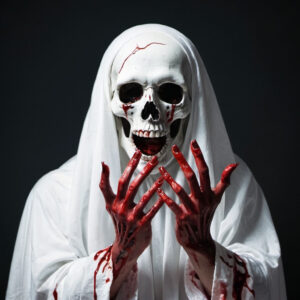
What Is a Ghost? Challenges and History of Ghosts
Introduction
Ghosts have captivated human imagination for millennia, weaving their way into folklore, religion, and pop culture. But what exactly is a ghost? How did the concept of ghosts come to be, and why do they continue to haunt our collective consciousness? In this in-depth exploration, we will delve into the definition of a ghost, examine the rich history of ghostly apparitions, and uncover the cultural and psychological factors that keep the idea of ghosts alive in modern society.
What Is a Ghost?
A ghost is traditionally defined as the spirit or soul of a deceased person or animal that has not found rest in the afterlife and thus lingers in the physical world. The term “ghost” is often used interchangeably with words like spirit, phantom, apparition, or specter. Ghosts are typically thought to inhabit certain locations, objects, or even people, often manifesting as visual apparitions, sounds, smells, or feelings of coldness.
However, the exact nature of a ghost varies significantly across cultures and belief systems:
1 Spiritual Beings:
In many religious traditions, ghosts are seen as the souls of the dead who have not yet ascended to heaven or moved on to another plane of existence. They may be trapped due to unfinished business, unresolved emotions, or a violent death.
2 Residual Energy:
Some theories suggest that ghosts are not conscious beings but rather residual energy left behind by traumatic or significant events. This energy can manifest as repeated scenes or sounds, similar to a recording being played back.
3 Psychological Manifestations:
In some cases, ghosts are thought to be the product of human psychology, a projection of our fears, desires, or unresolved emotions. These manifestations are not spirits of the dead but rather creations of the human mind.
4 Cultural Constructs:
It is also possible to view ghosts as cultural creations influenced by folklore, customs, and society beliefs. What is viewed as a ghost in one culture might be viewed as an angel, devil, ancestral spirit, or another kind of supernatural being.
The History of Ghosts
The belief in ghosts is one of the oldest and most universal aspects of human culture. From ancient civilizations to modern-day ghost hunters, the concept of the spirit world has been a constant presence in human history. Let’s take a journey through time to explore how the idea of ghosts has evolved.
1. Ancient Ghosts: The Beginnings of Belief
The belief in ghosts dates back to prehistoric times, as evidenced by ancient burial practices and rituals designed to appease the spirits of the dead. Early humans believed that the soul continued to exist after death and could influence the living.
Mesopotamia: The Sumerians, one of the earliest civilizations, had a rich tradition of ghost stories. They believed that the dead resided in the underworld, and if not properly buried or remembered, they could return as ghosts to haunt the living. Ghosts in Mesopotamian culture were often malevolent, seeking revenge or justice.
Ancient Egypt: In ancient Egypt, the belief in the afterlife was central to their culture. The Egyptians believed that the soul (ka) could leave the body after death but would need to return to it. If the ka was not properly cared for, it could become a restless ghost. Tombs and pyramids were built to ensure the safe passage of the soul, and elaborate rituals were performed to prevent the dead from becoming malevolent spirits.
Ancient Greece and Rome: The ancient Greeks and Romans had a complex view of the afterlife, with ghosts playing a significant role. The Greeks believed in shades (psyche), which were spirits of the dead that resided in the underworld. These shades could return to the living world, particularly if they had died violently or without proper burial. In Roman culture, ghosts (lemures) were also feared and were thought to haunt the living, especially if they had been wronged in life.
2. Ghosts in the Middle Ages: The Rise of the Haunted
During the Middle Ages, the Christian Church’s teachings on the afterlife shaped the belief in ghosts in Europe. The Church promoted the idea of purgatory, a place where souls were purified before entering heaven. This led to the belief that ghosts were souls trapped in purgatory, seeking prayers and penance from the living to move on to the afterlife.
Medieval Europe: Ghosts in medieval Europe were often seen as omens or warnings. They were thought to appear to the living to deliver messages, often related to unconfessed sins or unfulfilled duties. These apparitions were taken seriously, with ghost stories frequently recorded in religious texts and literature. One famous example is the “Visio Pauli,” a medieval text that describes a journey through the afterlife, where ghosts of the dead appear to the living to warn them of the torments of hell.
The Danse Macabre: The Black Death and the constant presence of death during the Middle Ages led to the rise of the Danse Macabre, or the Dance of Death, a popular artistic motif that depicted skeletons leading the living to their graves. This imagery reflected the belief that death was always near and that the dead could return to remind the living of their mortality.
3. The Renaissance and Enlightenment: Ghosts Under Scrutiny
The Renaissance and Enlightenment periods brought about a shift in the way ghosts were perceived. The rise of science and reason challenged traditional beliefs in the supernatural, leading to skepticism and a more critical examination of ghostly phenomena.
Renaissance Ghosts: During the Renaissance, the study of the natural world and the human psyche led to new interpretations of ghosts. Some scholars began to argue that ghosts were not spirits of the dead but rather hallucinations or the result of a disturbed mind. Despite this skepticism, ghost stories continued to be popular, with works like Shakespeare’s “Hamlet” featuring ghostly apparitions as key elements of the plot.
The Enlightenment: The Enlightenment further challenged the belief in ghosts, as rational thought and scientific inquiry became the dominant modes of understanding the world. Many intellectuals dismissed ghosts as superstitions, arguing that natural explanations could account for ghostly encounters. However, the fascination with ghosts persisted, and the 18th century saw the rise of ghost clubs and societies dedicated to investigating and debunking ghostly phenomena.
4. The 19th and 20th Centuries: The Age of Spiritualism
The 19th century marked a resurgence of interest in ghosts, driven in part by the rise of spiritualism, a religious movement that claimed to communicate with the spirits of the dead. Spiritualism gained popularity in the United States and Europe, leading to widespread belief in ghosts and the afterlife.
The Fox Sisters: In 1848, the Fox sisters of New York claimed to communicate with a ghost through mysterious rapping sounds. Their claims sparked a wave of interest in spiritualism, with séances and spirit communication becoming a popular pastime among the middle and upper classes. The movement attracted both believers and skeptics, with famous figures like Arthur Conan Doyle and Harry Houdini getting involved in the debate over the existence of ghosts.
Victorian Ghost Stories: The Victorian era saw a boom in ghost literature, with writers like Charles Dickens, Henry James, and M.R. James penning classic ghost stories that remain popular today. These stories often explored themes of guilt, memory, and the supernatural, reflecting the anxieties of the time.
The 20th Century: The 20th century saw the rise of paranormal investigation as a field of study. Ghost hunters and paranormal researchers used scientific methods and technology to investigate reports of hauntings, leading to the emergence of modern ghost hunting as a popular hobby. Television shows, movies, and books about ghosts proliferated, further cementing the presence of ghosts in popular culture.
5. Ghosts in the 21st Century: The Digital Age of Hauntings
In the 21st century, ghosts continue to be a source of fascination and fear, with the digital age providing new platforms for ghost stories and investigations.
Internet Ghosts: The internet has given rise to a new form of ghostly encounters, with stories of haunted websites, cursed emails, and ghostly digital apparitions circulating widely. Social media platforms like Reddit and YouTube have become hotbeds for ghost stories and paranormal investigations, with users sharing their own experiences and evidence of hauntings.
Paranormal Tourism: Ghost tours and haunted attractions have become popular tourist destinations, with cities around the world offering guided tours of haunted locations. These tours often combine history with ghost stories, providing a unique way to explore the past and the supernatural.
Ghosts in Pop Culture: Ghosts continue to be a popular subject in movies, TV shows, and books. From horror films like “The Conjuring” to animated series like “Ghostbusters,” ghosts have remained a central figure in pop culture, reflecting our enduring fascination with the unknown and the afterlife.
The Age of Ghosts: A Deep Dive into the Era of Spiritualism and Its Impact
Influence on Literature and Art
The Age of Ghosts had a profound impact on literature and art, inspiring countless works that explored the supernatural and the afterlife. Ghost stories became a popular genre, with authors like Edgar Allan Poe, Charles Dickens, and Henry James writing tales of haunted houses and spectral apparitions. These stories continue to captivate readers today, with many being adapted into films, TV shows, and other forms of media.
In brief
The concept of ghosts has evolved over thousands of years, shaped by cultural, religious, and psychological factors. From ancient spirits of the dead to modern-day digital apparitions, ghosts continue to haunt our imaginations, serving as a reminder of the mysteries of life, death, and what may lie beyond. Whether seen as spirits of the deceased, residual energy, or psychological manifestations, ghosts remain an enduring part of human culture and a testament to our fascination with the unknown.
